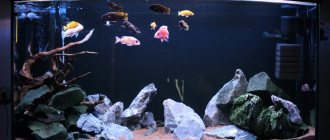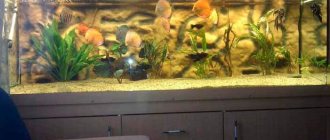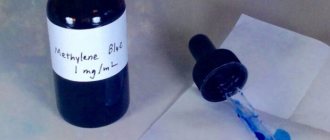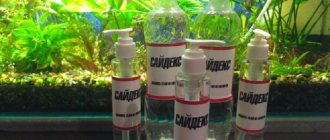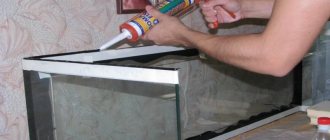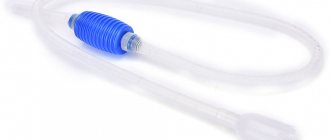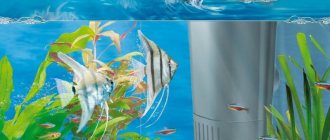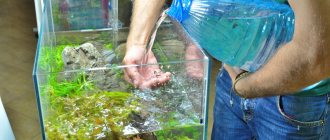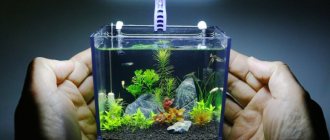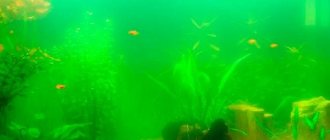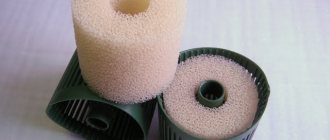An artificial pond in the interior of a home plays the role of a bright accent. A coordinated composition with thoughtful details does not fall out of the overall design of the room, but becomes a natural extension of the room. There are many original design techniques that will make a fish tank unusual.
Beautiful interior Source roomester.ru
Built-in aquarium in the kitchen Source srbu.ru
Unusual work apron Source www.topdom.ru
Basic styles
Aquarium science distinguishes several types of aquarium design. But everyone is able to complement and improve aquadesign. Below are the main decorative styles for aquariums.
Dutch
This style first appeared in the middle of the last century and is still popular among aquascapers. The peculiarity of the Dutch style is the more, the better, or the complete filling of free space. This is especially true for the bottom part. Do not leave empty areas at the bottom. A large amount of vegetation of different levels is planted, the contrast of red and green colors is especially welcome. In the middle, attention is drawn to a snag or a structure made of large stones.
Pseudo-sea
Creating a pseudo-marine style does not require large investments. It requires standard soil and undemanding plants. The backlight is preferably blue. For additional resemblance to the sea, shells, artificial shells, and corals are used for the soil.
Natural
When using a natural style, it is important to create an interconnected and holistic composition of nature. There are several completed variations in the natural style:
- Rock garden. The main part of the decorations are stones. Sometimes stone figures have a hidden meaning.
- Iwagumi. Stones and Japanese dwarf trees are used, complemented by figures of houses, ships, and boats.
- Reboku. The focus is on driftwood and large stones.
- Wabi-kusa. A distinctive feature of this option is the presence of a moss hummock above the surface of the water. The plant that is used as tussock is called wabi-kusa, hence the name.
Several Important Factors
Before you get down to business, study what an aquarium in general is, how to properly care for it, and how to decorate it correctly. To begin with, it is worth understanding that we are dealing with an entire ecosystem, displayed in minimalist dimensions. In addition, we are interested in the design side of the issue, so we need to approach the matter from different angles.
Fish are very demanding both to environmental conditions and to their neighbors.
When decorating, consider several important factors:
| Accent | Varieties |
| Aquarium view | Sea, river |
| Bowl shape | Round, rectangular, convex, square |
| Type of scenery | Natural, artificial |
| Composition form | Convex, concave, rectangular, triangular. |
Lighting plays an important role in aquarium design.
It is necessary to place emphasis on these factors, as well as on existing varieties when working. We need to return to them, so it’s worth considering them in detail and finding out their features.
See also Decorating the interior with moss, photo.
Aquarium view
There are two main varieties: sea and river. This is a very important factor. It influences the choice of inhabitants, plants, decorations and even water.
Important! To fill a marine aquarium you need sea water.
The difficulty of maintaining such a system lies in the complexity of filling it. Finding sea water for sale is not easy, and the sea is not always nearby. For this reason, such systems are not popular, but they still exist.
In this case, the scenery is selected appropriately. There are many wonderful sea fish that are suitable for living at home. They themselves are a good decoration, but still the emptiness should be diversified.
Harmonious design reminiscent of a Japanese rock garden
The most common decoration is the barrier reef. It can be either natural or artificial. The latter is more common, as it is easier to maintain and organize. All you need to do is purchase such a decoration and install it along the back wall of the aquarium.
The river one gives more space for creativity, is easy to care for and organize. Here you can use rain, distilled, or even tap water (but be sure to let it sit for a while before use).
See alsoAquarium design
Bowl shape
This factor largely influences the choice of composition form and design as a whole. From our school physics course, we know that glass can distort an image. And the more the glass is curved, the greater the deformation. Therefore, be sure to pay attention to the shape of the bowl, and view the resulting work of art from different angles.
When choosing an aquarium design, you need to take into account the style of the room.
Rectangular bowls are the most popular. They are easy to clean, install, decorate, and secure equipment. In addition, they have a lower price than other varieties. Such a bowl practically does not distort the image, so you can safely select any type of composition.
Rectangular aquariums are the most inexpensive, and the picture in them is not distorted
Square ones have similar characteristics. However, there is a slight distortion due to the identical ribs of the bowl, so a rectangular, flat design structure will not work in this case.
Convex are a rectangular bowl with a curved front wall. The foreground is deformed accordingly. Convex or concave structures are selected for such bowls.
Aquariums with a convex front glass are called panoramic and have a spectacular view.
A small round aquarium looks great on a nightstand near a sofa or bed
You need to be careful with round shapes. In general, they are not popular because they are difficult to clean and decorate. They are also small in size. In this case, single jewelry would be the best choice.
See also: Choosing decorative curtains for a doorway, photo.
Composition form
Now directly about the issue of creating a structure, which we touched on above. There are 4 main types of composition, the differences of which affect their compatibility with the shape of the aquarium:
- Convex. Has larger and smaller items in its composition. Its peculiarity is that large elements are displayed in the center, or at the back wall. Moreover, several large elements are used here, which will be on the same level. Then the objects are arranged in order of decreasing size, building the composition from the center to the front wall.
- Concave. The principle of arrangement is the opposite of the previous one. Volumetric elements are placed along the periphery, the size of the following ones gradually decreases towards the center. In this case, be sure to ensure that the decorations do not overlap each other.
- Triangular. The principle of arrangement is similar to the first option. In this case, it is necessary to find the reference highest point and create a structure from it. So, choose the tallest decoration and place it anywhere. Then, gradually reducing the size of the decorations, bring them to another point.
- Rectangular. Not as simple an option as it seems. In this case, the entire space is filled with elements of the same size. The difficulty lies in selecting components and arranging the structure in such a way that all the details are visible from different viewing points.
Beautiful composition of driftwood and seaweed
"Real" mountains at the bottom of the aquarium
This design may be suitable for an aquarium in a children's room.
Now you know how you will arrange the future composition depending on the type and shape of the aquarium. Let's move on to creating the design.
See also: Decorating a hall for a wedding with your own hands: photo ideas
General instructions for setting up an aquarium
When decorating an aquarium with your own hands, there are certain fundamental principles. The main one is that when decorating an aquarium, underwater pets are moved to a separate tank. This will help avoid injury, damage and stress to the fish. It is better to move the water along with the fish so that their body does not experience additional stress due to a sudden change in water. After decorating, pour water into the aquarium.
The second rule is mandatory disinfection of all new items with which the aquarium will be decorated. Even items that cannot be replaced are processed after some time.
Aquarium invertebrates
Some types of aquariums do not require the presence of fish , but this does not mean that you need to completely abandon the presence of fauna in the reservoir.
Invertebrates such as snails or shrimp can be an excellent alternative. They not only diversify the interior of the reservoir , but also help maintain the microclimate in it.
Decoration stages
Creating an aquarium design takes place in several stages and affects all areas.
Background
To decorate an aquarium, films or models made independently are used as a background. The right choice of background visually increases the space and creates the integrity of the underwater design.
Priming
For beginner aquarists, it is recommended to buy ready-made soil mixtures. When making soil yourself, it is difficult to take into account all the criteria, for example, particle size, color of the soil, what origin the soil is from. But when deciding to choose the soil yourself, take into account the type of fish and the general background of the aquarium.
How to choose a container for different rooms
The main rule of choice concerns the correspondence between the size of the artificial reservoir and the room in which it is planned to be installed. You cannot place a large aquarium in a small room. In this case, you can provide miniature options or objects of non-standard shape (for example, in the form of a column).
It is necessary to provide space for equipment (filter, cooler, etc.) in advance.
Consider also how well a particular model will fit into the design of the room. There are different decorating styles that may not suit any given room. If there is free space only in the window area, you should refuse to install the container in this room.
Fish and plants should not be exposed to direct sunlight as this will cause them serious harm.
Filling procedure
When decorating, there are several stages that are mandatory for anyone who decides to engage in aquascaping.
- Choose a design style or develop your own design.
- Buy selected items from a pet store.
- Treat stones and wooden parts if you choose them outdoors.
- Process purchased items.
- Fill up the soil.
- Arrange the decorative pieces.
- Secure the equipment.
- Plant plants if necessary.
- Fill with water.
- Add underwater inhabitants.
If you use sea corals to design an aquarium, they are placed in the aquarium only after all inhabitants have settled.
Aquascaping in 100 liters
This volume of the vessel expands the boundaries of creativity. Here you can use different aquarium plants, decorating it in the Dutch style, or use a minimum of elements and create aquascaping in the style of an Iwagumi or Zen garden.
You can put a small artificial castle on the bottom of the aquarium
Home aquarium design option
For example, decoration with Eleocharis sp. "Mini" will create a soft lawn that does not grow and does not require regular mowing. You can also supplement the aquarium with a couple of stones and a driftwood with moss in the form of a bonsai. To do this, you can use Java moss, which is unpretentious in cultivation, and the only requirement for full growth is an established carbon dioxide circulation system. In dim light, Java moss will have an oblong shape and a light shade; in bright light, its texture will be denser, and its shape will be more compact and neat.
An aquarium with algae and pieces of wood will look very beautiful
You can put stones in the aquarium
The aquarium can be built into the interior opening
See also Bottle decor for rooms in different styles
Aquascaping Ideas
- An aquarium with large objects and large inhabitants.
- Minimalistic style.
- Using corals.
- Use of fluorescent parts.
- Create an opening in the wall.
For 50 liters
A small 50 liter freshwater aquarium will be a good preparation before purchasing larger tanks. It is easy to maintain such a volume; it is easier to provide the necessary conditions and install aeration and filtration systems. Slow-growing plants take root well in such a space, but it is not recommended to plant fast-growing ones; they require frequent pruning of overgrown parts. Not all types of fish can live in a space of 50 liters, only small and medium-sized ones. For example, swordtails, guppies, zebrafish, molynesias. Larger species will not have enough space.
Developing an action plan
It's a good idea to come up with a plan of action. Firstly, it is always easier to act according to plan. Secondly, you will have a list of necessary decorative elements and equipment .
Thirdly, having ready-made instructions for action, it is much easier to adapt to unexpected circumstances.
Filling procedure
It doesn’t matter in what style the work on designing the reservoir will be done - in order for it to function for a long time, there are a number of general rules for starting it up:
- At the time of filling the aquarium with decor and starting the aquarium, the fish should be kept in a separate small tank, undergoing quarantine before moving in.
- All decorative elements must be disinfected so as not to become a source of infection for living organisms.
- When all the necessary equipment is installed, you need to make sure that it is in working order.
- Let the filled reservoir sit for a week to form its own microclimate, and only after that introduce inhabitants into the aquarium.
Photo
The meeting of two elements: fire and water
The imagination of designers knows no bounds. It would seem that there is enough space in the house to install an aquarium. But they suggested a fireplace. Why? It turns out that the combination of imitation fire on logs and the beautiful water world becomes extremely effective. Those who decide to combine an aquarium with a fireplace will have a lot of work ahead of them.
Chic aquarium around the fireplace in the living room
It will be easier to combine an aquarium with a fireplace if the latter is an imitation and not a real hearth
The process will turn out to be quite labor-intensive; you need to correlate the electrics of the fireplace and the aquarium so that they do not intersect, and try to ensure that in the event of a leak, a short circuit does not occur. But when all the issues are resolved and the two elements - fire and water - are on the same plane, the impression will be amazing. Now you can not only admire the dance of the flame, but also watch the movement of beautiful fish and vibrant flora.
Let's launch the fish
And here it is, the long-awaited moment - the launch of the first residents. They will be minors - medium-sized, but very bright and attractive schooling fish.
Tetra SafeStart and Tetra Bactozym were used so that the fish could be immediately introduced into a freshly started aquarium.
Minor is a peaceful schooling fish
Job completed! Now we just have to wait for the plants to take root and grow.
The aquarium is finished
Starting an aquarium with live plants is not as difficult a task as it might seem at first glance. With the help of unpretentious plant species and tools for quickly starting an aquarium, you can easily create your own unique corner of the underwater world.
Where to install?
The aquarium must be placed in such a way that it is naturally lit, but not exposed to direct rays. The place should be reliable and stable, but still allow you to easily carry out general cleaning, change the water, or feed your pets. A good place is the side opposite the window opening. It will be good if there is a socket nearby for connecting existing equipment: a filter, a heater, a compressor and the same lamp.
For safety, the level of the sockets should be higher than the level of the aquarium itself, since water ingress can cause burnt electrical wiring.
Easy access to water is also a plus, as it greatly simplifies the water change procedure. You should not place the tank near a TV or computer, as fish do not react well to noise.
Lamp Biodesign I-PRO
- Mounted, diode lamp for aquarium, Biodesign I-LED PRO 1000.
- Aluminum body, anodized.
- LED lamp with high power and good spectrum for illuminating an aquarium and growing live aquarium plants.
- The lamp is adjustable in length from 94-116 cm.
- Metal sliding legs with reliable fastening to glass; with their help, the lamp can be installed on aquariums of different lengths and its height can be adjusted from 0 to 12 cm.
- Case width 5.3 cm. Case height 1.6 cm.
- Installed on aquarium glass with a thickness of 3-10 mm.
- Lighting power 41 W.
- Color temperature (Kelvin K) 7000.
- Luminous flux per 1 m length (lm) 5500.
( 1 rating, average 5 out of 5 )
Plants
Plants are planted in a 100-liter aquarium to create an attractive design and enrich the water with oxygen. Suitable for this volume:
- hornwort;
- riccia;
- Anubias;
- Java moss;
- cryptocoryne;
- Vallisneria;
- elodea.
Hornwort.
Riccia.
Anubias. Java moss.
Cryptocoryne. Vallisneria.
Elodea.
On a note! Plants should be in harmony with each other, the inhabitants of the pond and the overall design.
